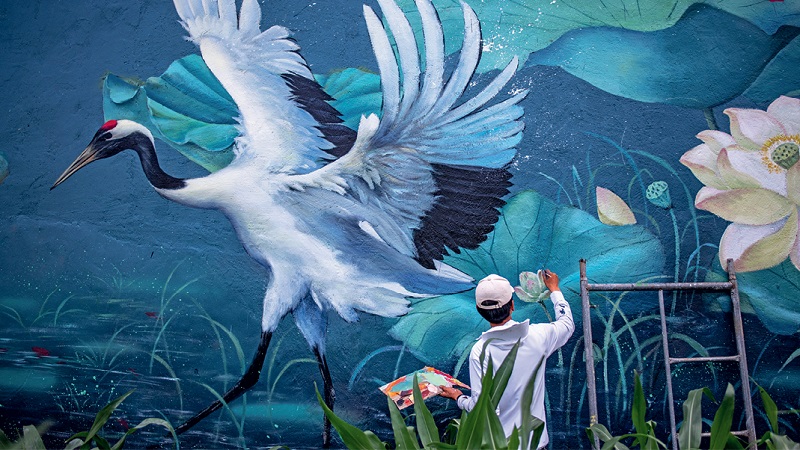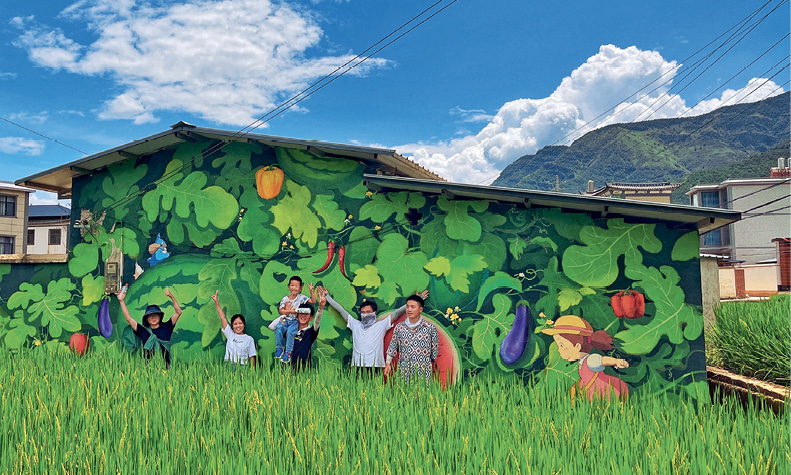A mural artist converts his village into a rural art gallery and inspires youth along the way.

Liu Xiaobei is painting a vivid red-crowned crane.
Each time the mural artist Liu Zhicheng, widely known as Liu Xiaobei, finishes painting a wall in his home village, he records the entire creative process on video. The jovial 27-year-old is often seen patiently talking to curious villagers about mural painting in paint-stained clothing and a distinctive white hat with a wide variety of eclectic painting equipment at hand. He paints from sunrise to sunset, and sometimes to midnight, driven by a passion that is obvious to everyone.
Liu posts his painting videos on social media and has become an online celebrity, attracting over one million subscribers and over eight million views. Some call him the contemporary Ma Liang, a famous figure from China’s folklore who painted with a magic brush. Mainstream media outlets such as Xinhua News Agency and CCTV have also reported on Liu’s story, and to the public he is seen as a youthful example of rural revitalization.
In fact, when Liu Xiaobei decided to do a painting in a village in Chongqing Municipality and then return to his home village in Yunnan Province, to paint for free, he didn’t expect that he would contribute to the cause of rural revitalization. To Liu, having the freedom to paint what he wants and where he wants is what drives him.
Liu Xiaobei was not born a painter. He took up painting as a hobby while a student, but didn’t spend too much time on it as he thought people who did so would be disconnected from the world. Liu was eager to interact with the world. Nonetheless, he gravitated to street art, which like graffiti, he thought, “Many people can see it, and the artist is free to paint anything he wants.” In college, Liu was inspired by Qi Xinghua’s works, which are very different from Western style graffiti. Liu thought Qi’s free painting style, which incorporates Chinese elements, especially the Chinese dragon, was cool, so he dropped out and made his way to Henan Province to learn how to paint murals.
“My teacher didn’t specify how to paint. After explaining the basic skills, he asked me to get familiar with the materials and then told me to paint a few simple cartoons on the wall. Gradually, he gave me more complicated paintings to copy, without telling me how to do it. He constantly pushed me and only gave some instruction when I got totally frustrated. Every time my teacher thought I had met his expectation, he raised the bar.”
Along with the stress of learning to paint, Liu had the added pressure from his family and friends questioning his decision. His parents urged him to give up painting, saying he couldn’t earn a living through this type of work. But Liu persevered.
At one stage the teacher asked him to paint an extremely difficult painting, which had no clear outline and required a deep understanding of light, shadow, and three dimensions. Liu failed and became so distraught that he left the studio to take time to reflect on why he had chosen this path. Ultimately, his passion for wall painting drew him back to the studio, and he continued to finish the painting. After struggling for another two months, he finally began to gain a deeper understanding of what he was doing, saw his skill improve, and became more confident.

A classic group-photo taken after Liu Xiaobei finished a painting.
Murals with Chinese Characteristics
In many of Liu’s videos, the backgrounds are crop fields, rolling mountains, or clear lakes. Roads branch out in all directions, and chickens cluck and dogs bark. It looks like a traditional Chinese landscape painting, and he paints in it.
Born and raised in a village of Yunnan Province, the deep affection for that land comes across in his art.
Liu loves Chinese-style paintings in particular. When he first encountered mural art he was astonished by Qi Xinghua’s Chinese-style paintings. “When everyone believed Western graffiti was incredible, a Chinese dragon suddenly appeared on the wall attracting wide attention. I felt a strong sense of national pride,” said Liu. In 2019 Liu, along with other artists, painted nine Chinese dragons in Chongqing, which became a major attraction at the time.
However, not everyone shared his ideas about mural subjects. When he first began painting for villagers in his hometown, he planned to paint a Chinese dragon. However, he was asked to stop because villagers thought it would bring bad luck as the dragon image was too powerful for the house structure. Many of his other murals were not well received by villagers either. “If you paint a bird, [for example], the more realistic the bird is, the more amazing they think you are [as an artist]. But if you add any changes, making it less realistic, they would think you are a bad painter.” Therefore, Liu often patiently communicates with villagers as he tries to strike a balance between what he wants and what villagers like.
Liu remembers when he began to feel he was gaining recognition after he painted three-dimensional pandas for an elder farmer in the village. The man liked the panda so much that he made a local snack for Liu, invited him in for a meal, and even said he wanted to pay for the mural. Villagers’ recognition has greatly encouraged Liu. Apart from the panda, he also drew his inspiration from local customs and culture. Murals with traditional Chinese elements, including landscape painting, mythical figures like the Cowherd and the Weaver Girl, and the red-crowned crane are well received by villagers.
Liu’s three favorite murals are Qingyi, Red-crowned Cranes, and Fighting the Pandemic. The first two are closer to the Chinese themes that Liu prefers to paint. They demonstrate the character in traditional Chinese opera and the symbol of traditional Chinese landscape painting respectively. By adopting strong visual images Liu hopes more people can see and learn the beauty of China’s traditional culture. Fighting the Pandemic, a tribute to frontline workers during the pandemic, is more like a mural with Chinese characteristics in the new era and is one of his followers’ favorites.

Liu Xiaobei (in the white hat) and his team taking a photo with children in front of a wall painting.
A Famous Village Artist
Fighting the Pandemic has left a deep impression on many children in his village, and some even told Liu that they want to be a doctor in the future. This motivates Liu.
“I think children need some inspiration. From my own experience, I think they should understand that nothing is impossible. Don’t think that living in a village has shackled your life. As long as you have ideas and goals, you can achieve many things,” he said. There are many left-behind children (children whose parents are migrant workers in cities) in the village, and Liu hopes that his murals can encourage children to dare to dream and bravely pursue their dreams.
Liu is popular with local children because he doesn’t lecture them. Instead, he talks to them as equals, often inviting them to participate in the creation of his murals. He tries to guide them to foster correct values, gives them confidence and makes them believe that with hard work anything is possible. He also cooperates with businesses to assist with charity in order to provide more resources to rural children.
“If you treat these children as equals, you will have a place in their hearts. If you do some cool things, you will be recognized by them. Then they would imitate you and see you as their example. I think being an example can have a positive influence on their thoughts and actions.” In the beginning, Liu was inspired by Qi Xinghua to learn mural painting. Now, to children in the village, he has become their Qi Xinhua and their role model. To borrow the words of Vincent van Gogh, Liu “dreams of painting and then he paints his dream.”
However, all the attention and fame will eventually fade away just like the image of the nine dragons in Chongqing, and one day he will finish painting all the walls in the village. What will happen then? Liu hopes that he can continue to paint in other villages for free as he feels his art has more impact there than in the city.
While most of his peers leave the village in droves for big cities, Liu, who chooses to stay in the small village, has become the very cool guy he once hoped to be.